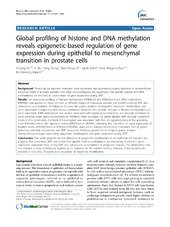| dc.contributor.author | Ke, Xi-Song | en_US |
| dc.contributor.author | Qu, Yi | en_US |
| dc.contributor.author | Cheng, Yang | en_US |
| dc.contributor.author | Li, Wen-Cheng | en_US |
| dc.contributor.author | Rotter, Varda | en_US |
| dc.contributor.author | Øyan, Anne Margrete | en_US |
| dc.contributor.author | Kalland, Karl-Henning | en_US |
| dc.date.accessioned | 2011-04-08T07:09:27Z | |
| dc.date.available | 2011-04-08T07:09:27Z | |
| dc.date.issued | 2010-11-25 | eng |
| dc.identifier.issn | 1471-2164 | |
| dc.identifier.uri | https://hdl.handle.net/1956/4637 | |
| dc.description.abstract | Background: Previously we reported extensive gene expression reprogramming during epithelial to mesenchymal transition (EMT) of primary prostate cells. Here we investigated the hypothesis that specific histone and DNA methylations are involved in coordination of gene expression during EMT. Results: Genome-wide profiling of histone methylations (H3K4me3 and H3K27me3) and DNA methylation (DNAMe) was applied to three cell lines at different stages of a stepwise prostate cell model involving EMT and subsequent accumulation of malignant features. Integrated analyses of epigenetic promoter modifications and gene expression changes revealed strong correlations between the dynamic changes of histone methylations and gene expression. DNA methylation was weaker associated with global gene repression, but strongly correlated to gene silencing when genes co-modified by H3K4me3 were excluded. For genes labeled with multiple epigenetic marks in their promoters, the level of transcription was associated with the net signal intensity of the activating mark H3K4me3 minus the repressive marks H3K27me3 or DNAMe, indicating that the effect on gene expression of bivalent marks (H3K4/K27me3 or H3K4me3/DNAMe) depends on relative modification intensities. Sets of genes, including epithelial cell junction and EMT associated fibroblast growth factor receptor genes, showed corresponding changes concerning epigenetic modifications and gene expression during EMT. Conclusions: This work presents the first blueprint of epigenetic modifications in an epithelial cell line and the progeny that underwent EMT and shows that specific histone methylations are extensively involved in gene expression reprogramming during EMT and subsequent accumulation of malignant features. The observation that transcription activity of bivalently marked genes depends on the relative labeling intensity of individual marks provides a new view of quantitative regulation of epigenetic modification. | en_US |
| dc.language.iso | eng | eng |
| dc.publisher | BioMed Central | eng |
| dc.rights | Attribution CC BY | eng |
| dc.rights.uri | http://creativecommons.org/licenses/by/2.0 | eng |
| dc.title | Global profiling of histone and DNA methylation reveals epigenetic-based regulation of gene expression during epithelial to mesenchymal transition in prostate cells | en_US |
| dc.type | Peer reviewed | |
| dc.type | Journal article | |
| dc.description.version | publishedVersion | en_US |
| dc.rights.holder | Copyright 2010 Ke et al; licensee BioMed Central Ltd. | |
| dc.rights.holder | Ke et al. | |
| dc.source.articlenumber | 669 | |
| dc.identifier.doi | https://doi.org/10.1186/1471-2164-11-669 | |
| dc.identifier.cristin | 826661 | |
| dc.source.journal | BMC Genomics | |
| dc.source.40 | 11 | |

